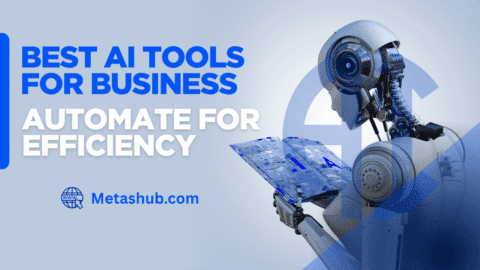The digital marketing world is evolving more than it ever has. The interaction of business companies and consumers is being transformed by the development of blockchain technology, dApps (decentralized applications), and NFT ecosystems.
Also known as Web3, this new era is providing businesses with a fresh opportunity to engage with their consumers in an open, imaginative, and community-focused manner.
In this post, we will define Web3 marketing plans, explain why they matter, and discuss how businesses can utilize them to stay at the cutting edge.
So what is Web3?
Before delving into marketing ideas, it is essential to understand what Web3 is.
Web3 is the third generation of the internet, a decentralized network powered by blockchain technology. With Web3, ownership and control are returned to the users, unlike with Web2, where data is controlled by centralised systems (i.e., Facebook/Google/Amazon).
Key characteristics of Web3 are:
Decentralization implies that there is no central business in charge of the network.
Blockchain-based infrastructure incorporates distributed ledgers used to register transactions and data.
Due to tokenization, Digital assets such as NFTs, utility tokens, and cryptocurrencies enable new companies to be in operation.
With the DAOs, users make a decision (Decentralized Autonomous Organizations).
The Ultimate Effect of Web3 on Marketing
The Web2 environment primarily utilizes cookies, precise data collection, and centered purchasing. There are problems with this approach:
Stricter laws on privacy (GDPR, CCPA)
Advert blockers and the dropping rate of click-throughs
A greater degree of consumer mistrust of centralized systems
The Web3 marketing approaches shift the equilibrium of power. Brands are free to communicate with their consumers, eliminate loyalty rewards, and develop communities that are very dedicated to developing them, rather than relying on the middlemen.
Central Web3 Marketing Methods
Some of the most effective marketing tactics developing in the Web3 world are shown here:
1. Campaigns for Engagement Based on NFTs
Non-Fungible Tokens (NFTs) are tools for community building and customer loyalty as well as digital art.
How they support marketing:
- Offer NFT owners early access to goods, events, or premium material.
- Gamified experiences: Design a collectible series with tasks that users must finish to earn incentives.
- Work with other NFT artists to cross‑promote audiences through brand partnerships.
For instance, a clothing company might put out a small number of NFTs, each of which gives the owner a 20% lifetime discount.
2. Social Media Marketing That Is Distributed
Algorithms and data are under the control of conventional social media companies. Web3 adds decentralized social networks like Lens Protocol, Mastodon, and DeSo, where users control their contacts and content.
Marketing gains:
- Direct audience ownership free of platform lock-in
- Honest statistics on participation
- Tokenized rewards for followers who participate in content sharing or engagement.
Brands can foster communities where participation is rewarded with tokens, therefore establishing mutual value exchange instead of one-sided marketing.
3. Brand Communities Based on DAO
Decentralized Autonomous Organizations, or DAOs, provide your audience control over the environment of your company.
Why does this produce results:
When individuals have a say in decisions, they are more involved. A DAO enables your most devoted clients to vote on:
- Novel characteristics of products
- Themes for campaigns
- Places of events
For instance, a gaming firm might set up a DAO whereby token holders decide on the following in-game character ideas.
4. Play-to-Earn and Engage-to-Earn Initiatives
Web3 lets users get incentives for engaging in marketing campaigns. This could be:
- Participating in sponsored blockchain games (Play-to-Earn)
- Interact with stuff, distribute posts, or participate in virtual activities (Engage-to-Earn).
- Tokens acquired may be used to purchase goods, NFTs, or perhaps traded for Bitcoin.
5. Loyalty Initiatives Using Blockchain
Blockchain loyalty tokens provide consumers with a transferable, tradeable asset rather than conventional loyalty points kept in a company’s database.
Advantages consist of:
- Cross-brand or platform compatibility
- Transparent rewards tracking
- Long-term client retention comes from the possession of actual assets.
Web3 Marketing Solutions: How to Apply
Although the chances are enticing, entering Web3 marketing calls for planning and preparation:
Train your team: Web3 ideas like smart contracts, NFTs, and DAOs might be new to your marketing team. Training is a must.
Start modest: Before deciding on more ambitious projects, try out distributed social media or launch a limited NFT campaign.
Work with Web3 communities: Work with artists, influencers, and projects already in the blockchain space.
Give openness top priority; the Web3 community appreciates honesty, security, and clear communication. Any unethical behavior will be immediately discovered.
Utilize OpenSea for NFTs, Snapshot for DAO voting, or Rally for tokenized communities to leverage the appropriate tools.
Web3 Marketing Problems
Although Web3 marketing offers great potential, it also presents difficulties:
- Technological difficulty: Non-technical marketers may find it challenging to configure blockchain connections, wallets, and smart contracts.
- Regulatory ambiguity: Crypto and NFT rules change from nation to nation.
- Adoption curve: The Web3 ideas remain unknown to a lot of consumers.
Brands ought to strike a balance between accessibility and innovation so that new participants can readily join in campaigns.
Marketing’s Path in Web3
Web3 marketing will probably combine in the next years with technologies like metaverse platforms, AI-driven personalization, and AR/VR experiences.
Companies that embrace community-first, tokenized interaction will have a significant competitive edge.
Our reality is changing from a “customer as a data point” to a “customer as a stakeholder” viewpoint. This translates to more meaningful brand-audience interactions, more engagement, and more trust.
Last Words
Web3 marketing solutions are not only a trend; they signify a profound change in the way companies develop, interact with, and keep consumers. Marketers who embrace decentralization, tokenization, and community governance can produce events that are future-proof, transparent, and rewarding.
Start modest, concentrate on value, and develop with your community if you’re ready to investigate NFTs, DAOs, blockchain loyalty, and decentralized social participation. The companies that adjust early will establish the benchmark for digital marketing for the following ten years.







